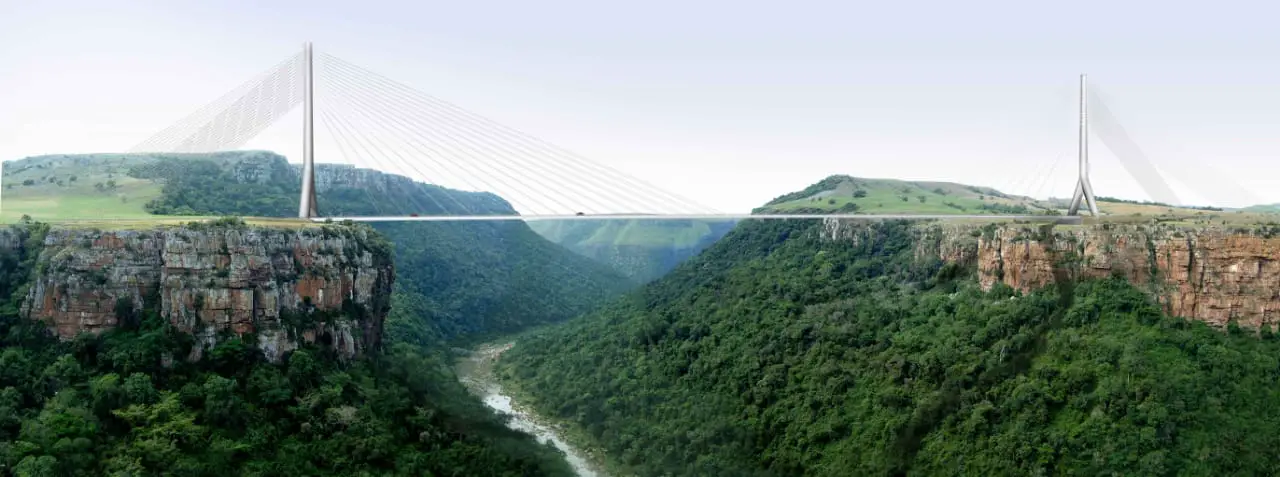The Mtentu and Msikaba mega-bridges are significant elements of the massive R40 billion N2 Wild Coast Road Project. It seeks to connect four South African provinces, Western Cape, Eastern Cape, KwaZulu-Natal and Mpumalanga. This infrastructure project will provide thousands of jobs and promote economic growth in the region. This was announced by South African President Cyril Ramaphosa in 2021. The mega-bridges will span across two major gully belts. These areas have for long considered direct travel from the port city of Durban to Cape Town. The new N2 highway alignment has the potential to save travel time of up to 3 hours.
It is estimated that it could boost tourism and provide between 8000 to 28,000 local jobs in its construction period. But this geographical and engineering scale faced environmental impacts and challenges. Therefore leading to endless delays in the mega-bridges.
Dissing+Weitling’s Vision for the Mtentu and Msikaba Mega-Bridges
Danish design by the architecture firm Dissing+Weitling is presented through Mtentu and Msikaba mega-bridges. Their grand yet eco-friendly proposals outperform any competing ones in an international tender. SANRAL, the South African roads agency managing construction was a sustainability design instruction. The visionary Danish architects link cultural aspects of the place with progress in engineering. The traditional wooden columns in the rural Tembu communities are cleverly reflected by Mtentu Bridge’s forest green pillars. The narrow, curved form minimizes wind shear throughout the majestic 260-meter central balanced projection.
Improved bridge angles, tower heights and cable stays were made possible by advanced computer modeling. Therefore protection against hurricanes, floods and possible earthquakes. The bridges also use solar energy and water conservation technology. The fusion of engineering know-how with indigenous materials and environment, the Danish designs embody innovation along sustainability for this part of globe. In spite of construction delays, the vision by Danish architects continues.
China Communications Construction and Mota Engil for the Mtentu Bridge
China Communications Construction Company and South Africa’s Mota Engil Construction won the R4.05 billion Mtentu Bridge contract. In 2019, other contractors withdrew because of the community protests. As part of the government agreement, they agreed to comply with strict local hiring quotas, subcontractor rules and onsite job training programs. Therefore, promotes equitable distribution of economic opportunities.
Mota-Engil through the regional head Tinyiko Mabunda says they intend to enable previously disadvantaged South Africans with upskilling programs on projects such as these bridges. The firms have also engaged local leaders and environmental activists to increase community acceptance. Through guiding widespread recruitment and sustainable construction policies, the South African government aims to ensure that local economic development based on both bridges is at its best. On the other hand, a long-term goal is building national infrastructure capacity through knowledge transfer with international partners implementing these megaprojects.
Mtentu and Msikaba Mega-Bridges Remarkable Feats
When finished, both the Mtentu and Msikaba mega-bridges will be continental records in their respective categories of bridge engineering. At the same time, along valley floor of Gorge spans a cable-supported main span 580 meters long that is to be Africa’s longest. With almost twice the length of the next longest cable-stayed deck, Msikaba certainly seems to be on its way toward civil engineering fame. With the polished white pylons reaching almost 200 meters above the valley, Msikaba is to be one of world’s longest cable-stayed bridges.
The remote valleys of South Africa reveal its best wilderness, which will attract people for generations. Nevertheless, as President Ramaphosa stated the saga of Mtentu and Msikaba mega-bridges depicts Africa’s growing infrastructure vision faced with challenges in undertaking such megaproject. However, their supposed economic implications for South Africa and the continent’s outstanding engineering standards make them worth their efforts.
Conclusion
The Mtentu and Msikaba mega-bridges are remarkable accomplishments. They represent South African infrastructure and engineering expertise in Africa literally as well as figuratively. However, the process has not been an easy one with major delays and stumbling blocks that have caused some uncertainty regarding when it will be completed. If done close to the new projection of 2024, these Mtentu and Msikaba crossings will certainly connect more than just distant shores. Their magnificent shapes spanning hundreds of meters over foggy valleys will be a symbol for infrastructure in Africa for generations. These mega-bridges in pushing the limits of infrastructure possibility reflect what cross country collaboration and human creativity can achieve on the African continent.
Also Read: Construction of the R4.05bn Mtentu Bridge begins
Also Read: SANRAL says Mtentu Bridge will be built
Also Read: Aveng, Strabag win US $125m Mtentu bridge contract in South Africa
Also Read: Mtentu Bridge tender in South Africa awarded
Also Read: Mtentu Bridge Construction to begin

